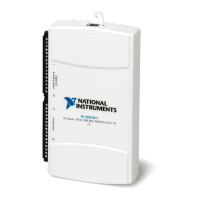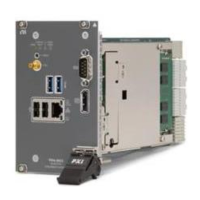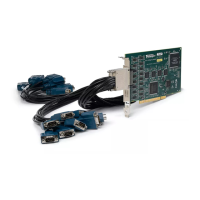© National Instruments | 3-23
NI 6612 User Manual
Channel Settings
By default, the counter:
• monitors for events on default PFI terminals. Refer to Chapter 5, Counter Signal Routing
and Clock Generation, for more information.
• looks for rising edges on the first signal and second signal.
• returns the measurement in the unit of seconds.
You can change these behaviors by configuring DAQmx Channel properties:
• CI.TwoEdgeSep.First.Term—The signal that the device monitors for the beginning event
comes from an input terminal. To change the signal to monitor, set this property to a
different terminal.
• CI.TwoEdgeSep.Second.Term—To change the signal to monitor for the ending event, set
this property to a different terminal.
• CI.TwoEdgeSep.First.Edge—Specifies on which edge of the first signal, rising or falling,
the device begins the measurement.
• CI.TwoEdgeSep.Second.Edge—Specifies on which edge of the second signal, rising or
falling, the device ends the measurement
• CI.TwoEdgeSep.Units—Specifies the units of the measurement.
Timing Settings
The timing settings determine when the device measures the signal. Figure 3-24 shows an
example of On-Demand timing.
On-Demand (No sample clock)
By default, the counter uses On-Demand timing. The following sequence of events describe
On-Demand timing:
1. Software calls DAQmx Start Task.
2. The device measures the time between the beginning and ending events.
3. The device waits until you call DAQmx Read. The device ignores the signals while waiting.
4. The device returns the measurement.
5. The device then detects the next beginning and ending events to make a new measurement.
6. Steps 3, 4, and 5 are repeated.
Implicit Timing
With Implicit timing, the device measures the time between every pair of beginning and ending
events. The measurements are stored in a buffer. Each call to DAQmx Read returns values from
this buffer. Figure 3-25 shows an example of Implicit timing.

